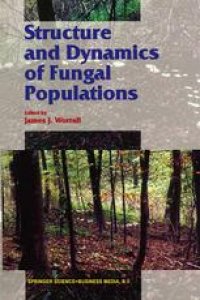
Ebook: Structure and Dynamics of Fungal Populations
- Tags: Plant Sciences, Soil Science & Conservation
- Series: Population and Community Biology Series 25
- Year: 1999
- Publisher: Springer Netherlands
- Edition: 1
- Language: English
- pdf
Fungi are among the most versatile and diverse groups of organisms in their morphology, life cycles, and ecology. This has provided endless fasci nation and intrigue to those who have studied fungi, but it has also made it difficult to understand fungal biology from the perspective of the broader fields of evolution, ecology, genetics, and population biology. That is changing. Details of fungal biology have been elucidated at an exciting pace, increasingly allowing us to understand fungi on the bases of general biological principles. Moreover, many who study fungi have lately emulated some of the great mycologists and plant pathologists of the early years in applying an insight born of broad perspective. This change has been particularly apparent in fungal population biology. In this book, many of those at the forefront of that change summarize, integrate and comment on recent developments and ideas on populations of fungi. By taking a broad perspective, they show how new information on fungi may contribute to concepts and ideas of biology as a whole. Just as important, they contribute to further invigoration of fungal population research by illuminating mycology with new ideas and concepts, derived in part from other biological fields.
This book is a comprehensive treatment of the population biology of fungi. Intended for mycologists as well as biologists without mycological background, it includes detailed coverage of all major taxonomic groups for which information is available and key topics in depth, including species concepts, somatic incompatibility, gene flow, role of sexual vs. asexual reproduction, mycoviruses, demography and fitness. Kinds and patterns of intraspecific variation are considered, including quantitative and especially molecular characteristics. Throughout, an attempt is made to relate aspects of fungal population biology to biology as a whole.
This book is a comprehensive treatment of the population biology of fungi. Intended for mycologists as well as biologists without mycological background, it includes detailed coverage of all major taxonomic groups for which information is available and key topics in depth, including species concepts, somatic incompatibility, gene flow, role of sexual vs. asexual reproduction, mycoviruses, demography and fitness. Kinds and patterns of intraspecific variation are considered, including quantitative and especially molecular characteristics. Throughout, an attempt is made to relate aspects of fungal population biology to biology as a whole.
Content:
Front Matter....Pages i-xii
Brief Introduction to Fungi....Pages 1-18
Defining Individual Fungal Boundaries....Pages 19-42
Defining Species in the Fungi....Pages 43-71
The Evolution of Sex and Recombination in Fungi....Pages 73-95
Gene Flow in Fungi....Pages 97-121
Somatic Incompatibility in Fungi....Pages 123-138
Genomic Conflict in Fungal Mycelia....Pages 139-174
Fungal Demography — Mushrooming Populations....Pages 175-194
Population Structure of Oomycetes....Pages 195-224
Population Structure of Ascomycetes and Deuteromycetes....Pages 225-250
Population Structure of Basidiomycetes....Pages 251-281
Viruses in Fungal Populations....Pages 283-305
Fitness, Continuous Variation and Selection in Fungal Populations: an Ecological Perspective....Pages 307-339
Back Matter....Pages 341-348
This book is a comprehensive treatment of the population biology of fungi. Intended for mycologists as well as biologists without mycological background, it includes detailed coverage of all major taxonomic groups for which information is available and key topics in depth, including species concepts, somatic incompatibility, gene flow, role of sexual vs. asexual reproduction, mycoviruses, demography and fitness. Kinds and patterns of intraspecific variation are considered, including quantitative and especially molecular characteristics. Throughout, an attempt is made to relate aspects of fungal population biology to biology as a whole.
Content:
Front Matter....Pages i-xii
Brief Introduction to Fungi....Pages 1-18
Defining Individual Fungal Boundaries....Pages 19-42
Defining Species in the Fungi....Pages 43-71
The Evolution of Sex and Recombination in Fungi....Pages 73-95
Gene Flow in Fungi....Pages 97-121
Somatic Incompatibility in Fungi....Pages 123-138
Genomic Conflict in Fungal Mycelia....Pages 139-174
Fungal Demography — Mushrooming Populations....Pages 175-194
Population Structure of Oomycetes....Pages 195-224
Population Structure of Ascomycetes and Deuteromycetes....Pages 225-250
Population Structure of Basidiomycetes....Pages 251-281
Viruses in Fungal Populations....Pages 283-305
Fitness, Continuous Variation and Selection in Fungal Populations: an Ecological Perspective....Pages 307-339
Back Matter....Pages 341-348
....